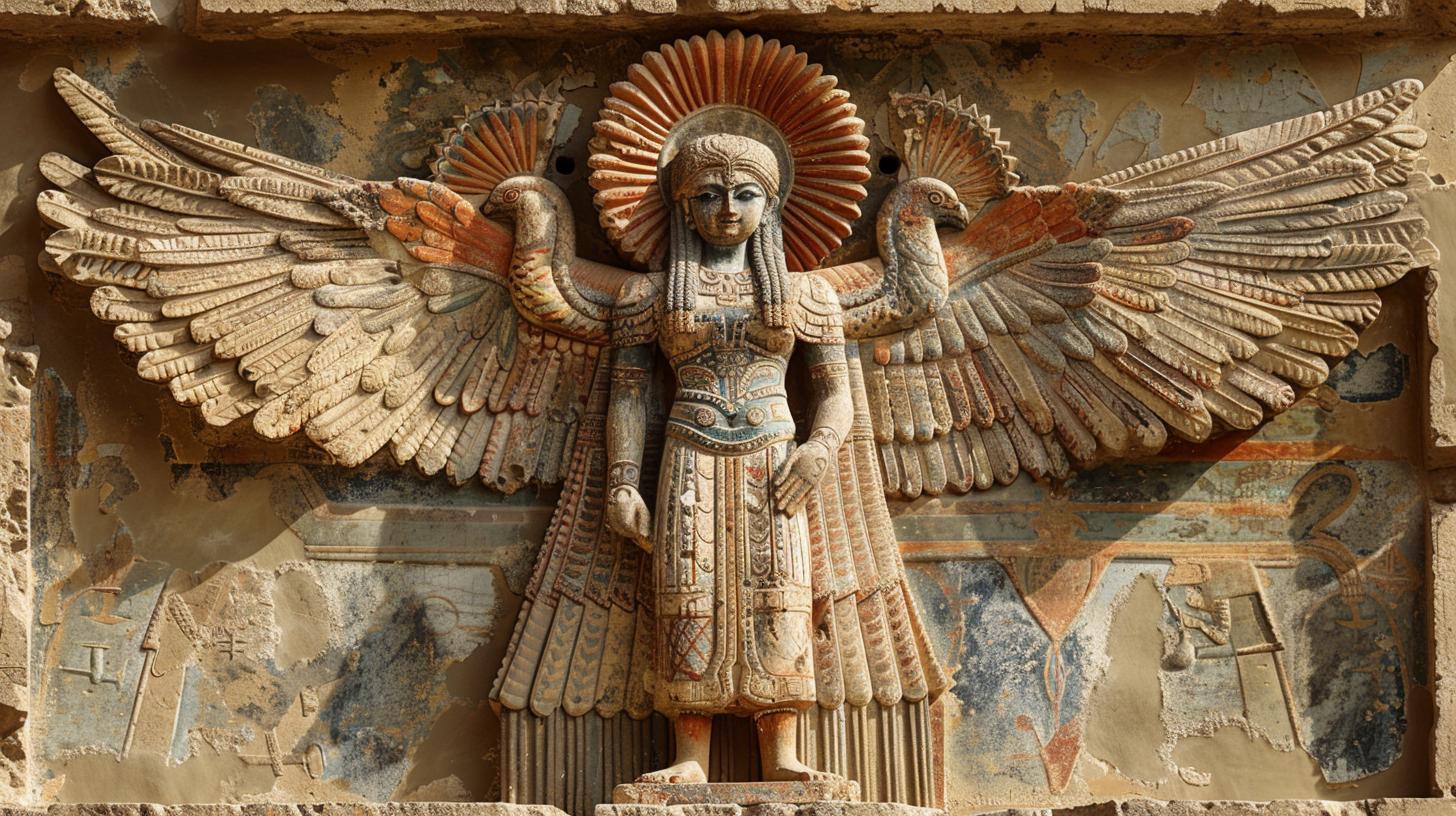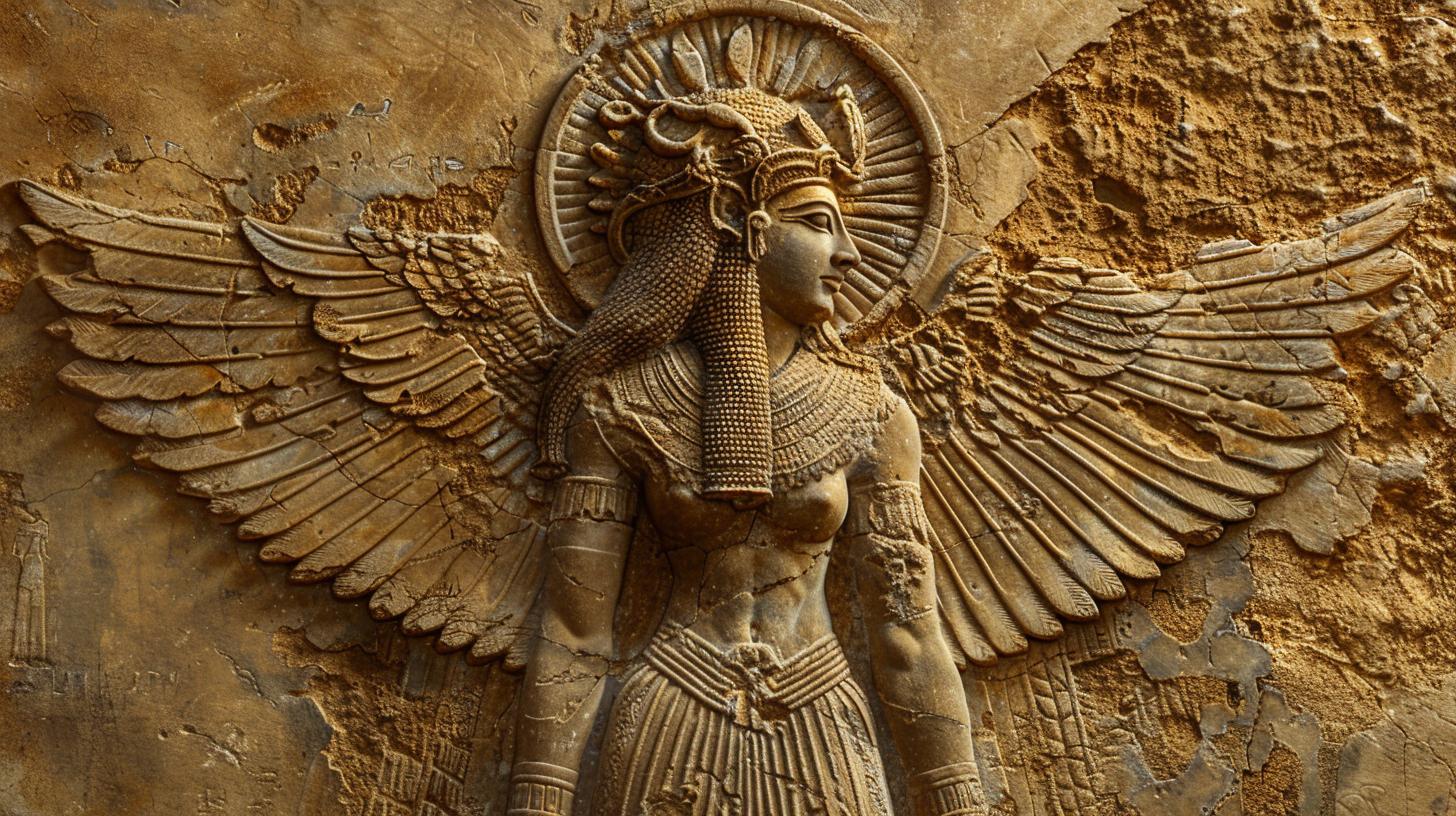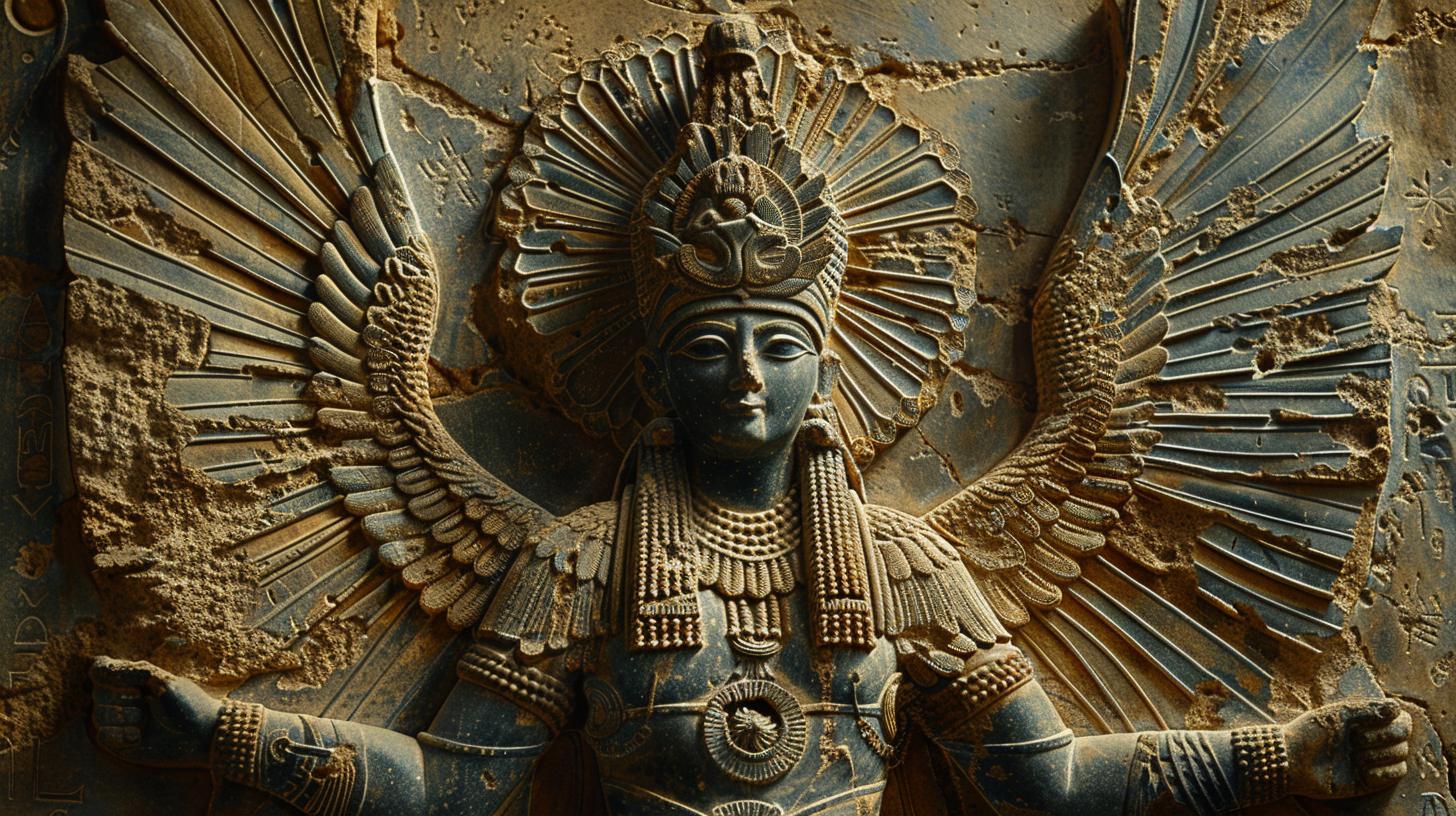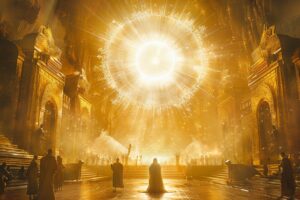Hebat Goddess: Origins, Worship, and Influence

Hebat, also known as Ḫepat, is a major goddess in the Hurrian pantheon from ancient northern Syria. Her name appears in various forms in cuneiform and Ugaritic texts. Scholars debate the origins and meaning of her name, with connections to Aleppo and Hurrian verbs.
Hebat holds significant status as a consort of weather gods like Adad and Teshub. She is often depicted in rituals related to childbirth and royalty. Her worship extended across regions, influencing Hurrian, Hittite, and Luvian religious practices.
The Origins and Name of Hebat
Hebat is an important deity in the ancient Near East with a complex name and origins. Researchers have explored various aspects of her name and its evolutions.
Analysis of the Name Hebat
The name Hebat appears in cuneiform as dḫé-pát or dḫé-pá-at and in the Ugaritic alphabet as ḫbt.
This complexity reflects the linguistic challenges of representing Hurrian phonetics. In modern texts, both ‘p’ and ‘b’ versions exist due to differing interpretations of these ancient sounds.
Variations and Romanizations
An interesting aspect of Hebat’s name is its inclusion in theophoric names, like those of Mittani princesses Kelu-Ḫepa and Tadu-Ḫepa, and the Hittite queen Puduḫepa. These names highlight the widespread reverence and adaptability of Hebat’s name across different regions and periods.
Theories on the Meaning
Connection to Aleppo
One theory posits that Hebat’s name is a feminine form linked to the city of Aleppo, suggesting a geographic origin or significant worship center. This connection offers insights into her cultural and religious significance in that ancient city.
Derivation from Hurrian Verbs
Another theory proposes that Hebat’s name derives from the Hurrian verb ḫbb, meaning ‘to love.’ This interpretation aligns with her roles associated with love, marriage, and maternity, adding a semantic layer to her identity.
Dismissed Connections to Biblical Eve
Some researchers have attempted to connect Hebat with Eve (Ḥawwa) from the Bible. However, these phonological similarities have been largely dismissed by the academic community due to a lack of substantial evidence linking the two figures.
Hebat’s Characteristics and Status
Hebat held significant roles and titles in the ancient Hurrian pantheon. She is often depicted as a queen and mother figure, deeply intertwined with royalty and maternity.
Epithets and Titles
Hebat is frequently referred to by epithets that signify her high status and veneration. Titles like “queen” and “lady of the sky” underscore her importance within the pantheon and her exalted position among the gods.
Associations with Royalty and Maternity
The goddess Hebat is strongly linked to concepts of royalty and motherhood. Her titles and veneration often emphasize her role as a maternal figure close to the royal household.
This close bond is also reflected in names of royal individuals featuring her theophoric element. Instances include Tadu-Ḫepa and Puduḫepa, showcasing her influence in royal circles.
Representation in Rituals for Childbirth and Royalty
Parallels with Consort Ceremonies
In the rituals associated with childbirth and royalty, Hebat’s role is strikingly parallel to the consort ceremonies dedicated to her divine partner, Teshub. These ceremonies often feature symbolism and activities that mirror those conducted for the king’s reign.
Symbolism in Ritual Texts
The ritual texts highlight Hebat’s importance through rich symbolism, underscoring her involvement in both birth and royal ceremonies. This symbolism often involves her maternal and queenly attributes, portraying her as a nurturing force and a regal entity.
Associations with Other Deities
Hebat’s significance within the Hurrian pantheon is also marked by her relationships and interactions with other deities, particularly weather gods and figures within her divine circle.
Relationship with Weather Gods
Early Association with Adad of Aleppo
In earliest records from Ebla, Hebat is associated with Adad, the storm god of Aleppo. This connection underscores her early integration into Hurrian and surrounding cultures’ mythologies.
Later Association with Teshub
Hebat later becomes the consort of Teshub, the Hurrian storm god, solidifying her status within the Hurrian pantheon.
Teshub’s prominence as a principal deity further elevated Hebat’s standing.
Connection to Tarḫunz
In the first millennium BCE, Hebat’s association shifts to Tarḫunz, the Luvian counterpart of Teshub. This transition reflects the fluidity of divine partnerships in ancient Near Eastern religions.
The Kaluti of Hebat
Her Divine Circle
Hebat’s ‘kaluti,’ or ritual offering lists, highlight key figures in her divine circle.
These kaluti emphasize familial and divine associations, essential to her worship.
- Šarruma: Her son
- Allanzu: Another child
- Kunzišalli: Her daughter
Mention of Divine Assistant Takitu
Takitu, mentioned prominently in the kaluti, serves as Hebat’s divine assistant. Takitu’s role reflects the hierarchical structure within the divine realm and the support system surrounding Hebat.
Comparisons to Sun Goddess of Arinna and Pidray
Distinctions in Roles
Though Hebat is compared to the Sun Goddess of Arinna in Hittite sources, important distinctions exist.
The Sun Goddess of Arinna holds significant solar deity attributes, while Hebat’s roles are more diverse, encompassing both royal and maternal elements.
Analogies in Ugarit
In Ugaritic texts, the local goddess Pidray is considered analogous to Hebat. Pidray’s attributes and roles share similarities, yet distinct cultural narratives define each deity.
Cult and Worship Practices
Hebat’s worship and rituals hold significant importance in ancient cultures, reflected in various texts and archaeological findings.
Early Evidence from Ebla and Surrounding Areas
The earliest evidence of Hebat’s cult comes from Ebla, where texts mention her, although she wasn’t a primary deity in the Eblaite religion. Her worship extended to surrounding areas, where she gained more prominence.
Festivals in Emar
In Emar, festivals were dedicated to Hebat alongside the local weather god. These festivals included various offerings and ceremonial acts aimed at honoring her role and attributes.
Worship in Yamhad and Alalakh
Hebat was also venerated in the kingdoms of Yamhad and Alalakh.
In these regions, she was integrated into local religious practices, and specific rituals were conducted to seek her favor and blessings.
Hurrian Religious Context
Within the Hurrian religious framework, Hebat’s worship was more prominently observed in the western states, with specific attention in their religious cities.
Western Hurrian States like Kizzuwatna
In Kizzuwatna, a central region in the western Hurrian states, Hebat’s main cult center was Kummanni. Her worship here involved elaborate rituals and offerings, signifying her high status in the Hurrian pantheon.
Lesser Importance in Eastern Hurrian Communities
In contrast, Hebat’s significance was relatively lesser among the eastern Hurrian communities. Although she was still recognized, her worship did not hold the same level of importance as in the western regions.
Hitite and Luvian Integration
Hebat’s influence extended into the Hittite and Luvian religious practices through cultural mediation from the Hurrians. This integration showcases the adaptability and enduring nature of her worship.
Recognition in Hattusa
In Hattusa, the Hittite capital, Hebat was acknowledged as an aspect of the Sun Goddess of Arinna.
Rituals held in her honor reflected her prestigious status and conferred legitimacy to royal ceremonies.
Influence in Tabal and Samʾal
Her worship spread to regions like Tabal and Samʾal during the first millennium B.C. Hebat’s presence in these areas underscored her lasting influence across different cultures and periods.
Later Identification with Hipta and Ma
Over time, Hebat was identified with other deities, such as Hipta in Lydia and Caria.
Classical sources also suggest links to the warrior goddess Ma, indicating her evolving nature and adaptation in various cultural contexts.
Rituals and Iconography
The rituals and iconography associated with Hebat reveal her significant role and high status in the ancient Near Eastern religious practices.
Ceremonies in Hattusa
Ceremonies honoring Hebat in Hattusa, the Hittite capital, underscored her importance, particularly in contexts of royalty and childbirth.
Rituals of Lordship and Reign
In Hattusa, rituals dedicated to Hebat often mirrored those of Teshub, the storm god, who was her consort. These ceremonies celebrated the lordship and reign of the divine couple, emphasizing their sovereignty and sacred union.
Hebat’s involvement in these rituals highlighted her role as queen and consort, integral to the religious and political fabric of Hittite society.
Symbolism in Birth Rituals
Birth rituals frequently invoked Hebat’s name, given her associations with motherhood and fertility. Texts describe ceremonies where the presence of Hebat was called upon to ensure the safe delivery of children.
Her epithet as ‘Lady of the Sky’ reinforced her protective and nurturing attributes, making her an essential figure during childbirth and related rituals.
Figurative Representations
The iconography of Hebat provides insight into her perceived character and the attributes ascribed to her by worshippers.
Matronly Depictions with Lion or Throne
Hebat is often depicted as a matron, symbolizing her authority and maternal aspects. She is frequently shown standing on a lion, an image signifying power and dominance. In other representations, she is seated on a throne, which highlights her royal status and role as queen among the gods.
These images reflect her high standing and widespread veneration.
Transition in Hellenistic Period
During the Hellenistic period, depictions of Hebat evolved. She often took on characteristics of other regional deities, blending with them as cultures intermingled. Representations of her during this time might show influences from local traditions, resulting in a fusion of symbols and aspects that showcased her adaptive nature and enduring significance.
Centers of Worship
Hebat’s worship centers were located throughout the region, each playing a crucial role in the religious practices of her followers.
Primary Centers Like Kummanni and Aleppo
Kummanni, known in the classical period as Comana Cappadociae, was a significant center for Hebat’s worship. This location was central to many religious rituals and ceremonies dedicated to the goddess. Aleppo also held a prominent place in the veneration of Hebat, being a major city in ancient Syria where she was deeply revered.
Other Significant Sites
In addition to the primary centers, several other locations were pivotal in the worship of Hebat. These sites contributed to the widespread veneration and the dissemination of her cult.
Emar and Alalakh
Emar was known for its festivals dedicated to Hebat, reflecting the city’s importance in her worship.
Alalakh also played a key role, with archaeological evidence suggesting the presence of sanctuaries and temples for Hebat.
Cities in the Taurus Mountains
The Taurus Mountains region housed several cities that were important in the worship of Hebat. The mountainous terrain and strategic locations of these cities made them vital centers for religious activities.
Influence in Asia Minor Religious Context
Hebat’s influence in the religious context of Asia Minor is notable, impacting multiple cultures and practices.
Hurrian Religion and Broader Impact
As a central figure in the Hurrian pantheon, Hebat’s worship spread across regions. Her religious significance extended beyond her native Hurrian context.
Integration into Hitite and Luvian Practices
Hebat was adopted into Hittite and Luvian religious traditions, highlighting her broad impact.
- In Hattusa, the Hittite capital, Hebat was recognized as an aspect of the Sun Goddess of Arinna.
This integration showcased the flexible nature of ancient pantheons, allowing deities from different cultures to coexist and assimilate.
- In regions like Tabal and Samʾal, Hebat continued to hold religious prominence. These states maintained ritualistic practices and ceremonies that honored Hebat, reflecting her lasting influence on regional worship.
- Over time, the goddess Hipta in Lydia and Caria emerged as a later form of Hebat.
This adaptation illustrates how her characteristics were preserved and transformed to fit local traditions.
- Classical sources linked Hebat with Ma, a warrior goddess of Comana. This connection underscores Hebat’s ability to embody diverse aspects, from maternal and royal to warrior-like qualities.
Transmission Across Cultures
Hebat’s veneration did not remain confined to one geographical area; her worship and characteristics were transmitted across various cultures.
- Her worship in Western Hurrian states like Kizzuwatna played a crucial role in this transmission. The religious practices from these areas influenced adjacent regions, disseminating Hebat’s cult widely.
- Hebat’s presence was also evident in less prominent Hurrian communities.
While her importance might have been lesser in these regions, the persistence of her worship points to her deep-rooted significance.
- The evolution of Hebat’s identity into figures like Hipta and Ma shows the fluidity and continuity of her worship.
These later forms maintain core aspects of Hebat’s characteristics, ensuring her presence in the religious landscape of Asia Minor persisted for centuries.
.





















